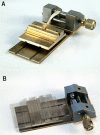A novel device for resistance-free biomechanical testing of the metaphysis of long bones
- PMID: 25048639
- PMCID: PMC4125708
- DOI: 10.1186/1471-2474-15-245
A novel device for resistance-free biomechanical testing of the metaphysis of long bones
Abstract
Background: Biomechanical testing is an essential component of bone research. In order to test the metaphyseal region of long bones, a typical location for the nowadays increasing field of osteoporotic bone changes, three-point bending and breaking test devices are suitable and widely used. The aim of our study was to increase the effectiveness of this method by using a newly developed ball-mounted platform design. This new design eliminates the negative effects of friction, present in previous studies, caused by the lengthening of the distal tibia along its diaphyseal axis while sliding over the surface of a fixed aluminum block.
Methods: 70 tibiae of 35 twelve week old, female Sprague Dawley rats were separated into two groups for a metaphyseal bending/breaking test. Group 1 was made up of the rat's right tibiae, Group 2 of the left tibiae. Group 1 was tested on a solid metal block according to previously established testing devices whereas Group 2 was tested on the newly designed device: the resistance-free gliding, ball-mounted platform. Stiffness (N/mm), yield Load (N), and failure Load (N) were registered. In the evaluation of both testing procedures, the results of the right and left tibiae were compared according to the rat they originated from.
Results: Stiffness (S) showed highly significant differences (p = 0.002) with 202.25 ± 27.010 N/mm SD (Group 1) and 184.66 ± 35.875 N/mm SD (Group 2). Yield Load (yL) showed highly significant differences (p < 0.001) with 55.31 ± 13.074 N SD (Group1) and 37.17 ± 12.464 N SD (Group2). The mean failure Load (fL) did not differ significantly (p < 0.231) between Group 1: 81.34 ± 11.972 N SD and Group 2: 79.63 ± 10.345 N SD.
Conclusions: We therefore conclude that, used in the three-point bending/breaking test, the mobile, ball-mounted platform device is able to efficiently eliminate the influence of friction in terms of stiffness and yield load. Failure Load was not affected. We suggest that the new ball-mounted platform device, when compared to other existing techniques, generates more accurate test results when used in the three-point bending/breaking test of the metaphysis of long bones.
Figures






Similar articles
-
Standardized bending and breaking test for the normal and osteoporotic metaphyseal tibias of the rat: effect of estradiol, testosterone, and raloxifene.J Bone Miner Res. 2006 Jan;21(1):89-96. doi: 10.1359/JBMR.050913. Epub 2005 Sep 26. J Bone Miner Res. 2006. PMID: 16355277
-
[A new three-point bending test for bone biomechanical properties of rat's tibia].Sheng Wu Yi Xue Gong Cheng Xue Za Zhi. 2008 Apr;25(2):341-5. Sheng Wu Yi Xue Gong Cheng Xue Za Zhi. 2008. PMID: 18610619 Chinese.
-
Whole bone testing in small animals: systematic characterization of the mechanical properties of different rodent bones available for rat fracture models.Eur J Med Res. 2018 Feb 14;23(1):8. doi: 10.1186/s40001-018-0307-z. Eur J Med Res. 2018. PMID: 29444703 Free PMC article.
-
Femoral metaphysis bending test of rat: introduction and validation of a novel biomechanical testing protocol for osteoporosis.J Orthop Sci. 2012 Jan;17(1):70-6. doi: 10.1007/s00776-011-0167-7. Epub 2011 Nov 2. J Orthop Sci. 2012. PMID: 22045451
-
Biomechanical and biological aspects of defect treatment in fractures using helical plates.Acta Chir Orthop Traumatol Cech. 2014;81(4):267-71. Acta Chir Orthop Traumatol Cech. 2014. PMID: 25137496 Review.
Cited by
-
Validation of a novel testing machine for the investigation of the biomechanical properties of lumbar vertebrae in an osteoporotic rat model.J Orthop Surg Res. 2023 Mar 31;18(1):263. doi: 10.1186/s13018-023-03751-3. J Orthop Surg Res. 2023. PMID: 37004118 Free PMC article.
-
Low-energy extracorporeal shockwave therapy (ESWT) improves metaphyseal fracture healing in an osteoporotic rat model.PLoS One. 2017 Dec 12;12(12):e0189356. doi: 10.1371/journal.pone.0189356. eCollection 2017. PLoS One. 2017. PMID: 29232698 Free PMC article.
References
-
- Stuermer EK, Seidlova-Wuttke D, Sehmisch S, Rack T, Wille J, Frosch KH, Wuttke W, Stuermer KM. Standardized bending and breaking test for the normal and osteoporotic metaphyseal tibias of the rat: effect of estradiol, testosterone, and raloxifene. J Bone Miner Res. 2006;21(1):89–96. - PubMed
-
- Peck WA. Concencus development conference: diagnosis, prophylaxis, and treatment of osteoporosis. Am J Med. 1993;94:646–650. - PubMed
Publication types
MeSH terms
LinkOut - more resources
Full Text Sources
Other Literature Sources
Medical

